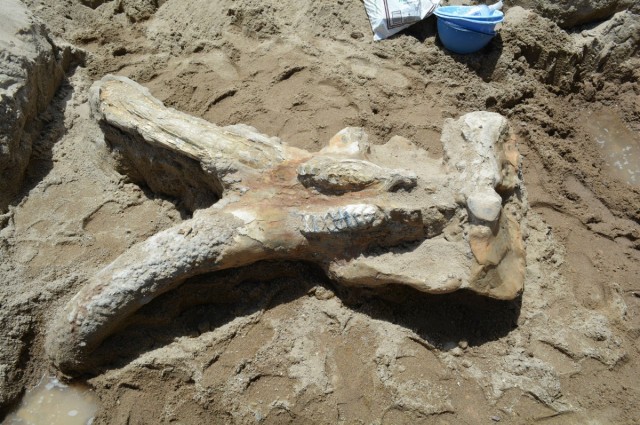www.iflscience.com | By Justin Alford | June 19, 2014

While most guys out on their bachelor party might be expected to stumble into a bar, a group of friends celebrating an upcoming wedding happened upon something rather more spectacular than a line of shots; a 3-million-year-old skull.
The chums were out hiking in Elephant Butte Lake State Park near Albuquerque, New Mexico, when they spotted something peculiar poking out of the sand, The Telegraph reported. The guys then started digging until the almighty skull emerged. They took a few pictures and sent them off to the New Mexico Museum of Natural History and Science, which quickly prompted resident paleontologists to check it out.
After the skull was excavated, it became immediately apparent that the specimen was exceptionally well preserved. “It’s almost a complete skull. The only thing that’s missing is the bottom jaw. The bottom teeth still have enamel on them,” Randall Gann, public information officer of the museum, told Mashable.
The scientists identified the skull as a stegomastodon, a prehistoric ancestor of modern day elephants that roamed the Earth during the Ice Age. While the 1,000 pound specimen may look like it belonged to a woolly mammoth, paleontologist Gary Morgan was able to determine that it was a mastodon and not a mammoth due to key differences in the teeth. Morgan told Live Science that while mammoths had ridged molars for grazing, mastodons donned cone-shaped molars more suited to chomping down twigs. (Mastodons are similar morphologically to Stegomastodon’s but they belong to a separate genus).
While it is not unusual for visitors of the park to find fossils, Morgan noted the rarity of finding such an intact specimen. “Normally we get bits and pieces,” he said. “A complete fossil find like this makes it much more important scientifically and more helpful in understanding the evolutionary history.”
Mastodons were around 10 feet (3 meters) tall and weighed between 3 to 5 tons. They journeyed to North America around 15 million years ago and roamed for many years before becoming extinct around 10,000 years ago. Scientists are still unsure of the exact cause behind the extinction.
Morgan estimated that this particular specimen, which was probably 50 at the time of death, would have stood around 9 foot tall and weighed around 6 tons.
Scientists will examine the skull further before it goes on display in the museum in order to find out more about the history of this species.









